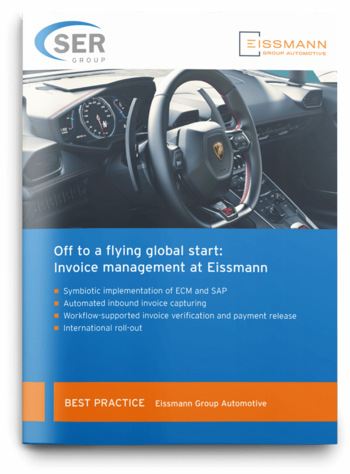SER Blog Customer Stories & Use Cases
5 reasons for automated invoice processing that might surprise you
There are obvious reasons for automating invoice processing, such as meeting deadlines for payment discounts. Let’s take this opportunity to think outside the box, though, and look beyond the reasons that solution providers typically give, like optimizing purchase-to-pay processes and expediting invoice approvals.

We've launched numerous projects for intelligent and automated invoice processing in recent years. In many of these projects, the obvious benefits were the reasons to move ahead, but they were certainly not the only ones. In fact, our customers often only see a small fraction of the overall benefits of processing invoices based on a content services platform like Doxis.
Nevertheless, the buzzwords and concepts are all the same for providers (we could win the grand prize in B.S. bingo). From a business perspective, these projects are good investments because of the well-known benefits. However, we're convinced that the real added value goes far beyond that and often cannot be fully accounted for financially. In the following, we'd like to share five of these reasons with you:
Reason 1: No more hunting for inbound invoices and business transactions
An inbound invoice is never created in a vacuum. The document itself might be, but it is preceded and sometimes followed by countless other documents. The process never starts with an invoice, but usually with a requirement or need. By the time you receive an invoice, many documents will have passed between your company and other companies – some documents have to be retained, others do not – some in paper format, others electronically, some by email and others as notes.
In such cases, an ERP system is usually used to create, send and post the most important outbound documents for your supplier. This stream of business documents is also easy to track. But what about the rest? Basically, one rule applies: the more complex the trigger for the inbound invoice (e.g. a construction project), the more documents will be created in advance. The resulting search, interdependencies and tracking become more complex.
For this reason, intelligent and automated processing of inbound invoices can be used as a blueprint for the entire business process once it has started. As a result, not only are the invoice and purchase order relevant, but the entire process can be mapped clearly, accurately and comprehensibly. Thanks to the 360-degree view of the process with its documents from the ERP system, the agreements, documents and emails, the user can easily access all the information without the hassle of searching.
Reason 2: Inbound invoice processing creates a transparent & company-wide information basis
Inbound invoices are not just a part of business processes. Office supplies, which are not very relevant to operations, are probably the exception here. However, let's analyze inbound invoices that result from a customer order, a project and agreement, and take a look beyond the actual business process:
You have signed an agreement with a customer for several orders as part of a framework project. So different areas will work together, and eventually you’ll receive a variety of inbound invoices. With digitized and automated processing of these invoices, you can also link the information from related areas in the company that might already exist in the form of eFiles for customers, orders, projects and agreements. In other words, it makes sense to reference each item and create a link between this information and the inbound invoices.
Here’s where the power of metadata comes into play – because nobody wants to do the assigning task manually. The inbound invoice has a reference to a purchase order number, possibly also to a project number. These two numbers can often be used to identify the reference to a specific project, agreement, customer and order, provided that these elements recognize the respective reference numbers. This also creates new options for making good use of the existing and logically stored documents and metadata. If you cannot yet establish this reference, perhaps this is something you want to address inr your next project? Or have you already thought about automatically managing inbound invoices for a project budget?
Reason 3: Inbound invoices are the kick-off point for automating many other processes
Similar to the previous reason, inbound invoices also play a role in other areas of the company. These can, of course, also impact sales and marketing. Maybe you have to buy products, services or components for which the costs are passed on to your customers.
Automation can also be useful here. Because by correctly extracting the relevant invoice information, just such information can be retrieved and the appropriate downstream processes can be triggered. Of course, passing on such costs is only one possible example. What type of example would you have?

Eissmann Group Automotive: International invoice management
Read all about how Eissmann Group Automotive transparently, swiftly and securely processes invoices worldwide.
Read nowReason 4: Inbound invoices improve the quality of your master data management
How much time do you spend on managing your master data? Companies often only work on master data when errors are detected, duplicates are found, or data has to be added. But there is often no standardized process for this activity. With the introduction of automated inbound invoice processing, you will have to work with the supplier master data, at the least. After all, the master data is critical for how well and reliably vendors, for example, can be identified.
The better quality and more complete the data, the better you’ll be able to identify the correct vendor and other information in the project based on different attributes, potentially too with a range of international invoices. These can likewise be checked regularly after the go-live. For example, if you receive inbound invoices with data that differs from your master data, this can be checked and updated, if necessary. Perhaps your supplier has changed its company name?
Reason 5: Inbound invoices are the prerequisite for streamlined processes
If you launch automated inbound invoice processing, you’ll also have to deal with your workflows and processes. While this can include the many special cases, we would initially set these aside, as they often add complexity to the project or are better handled on a case-by-case basis.
We regularly see both types of cases in projects. The most important thing for you to know is this: You will be involved extensively with your own processes before, during and after the rollout. The overall process with all the many paths an inbound invoice can take is mapped and documented, and this provides the basis for digital processing from invoice receipt to posting.
This process implementation also provides important insights from previous paper-based processes which are now being translated into automated structures. Our approach helps you to better understand your processes, e.g. how you define decision-making paths, and enables you to draw important conclusions that will help you to optimize your processes. These don't have to be improvements related directly to inbound invoices, but they can have a positive impact on other processes. In short, inbound invoicing is ultimately the result of upstream and downstream processes in your company.
...and that’s not all
These reasons provided here should give you a look at the big picture related to automated invoice processes. This particular process might be one of many thousands in every company – but it is a central one as it leads directly to financial expenditures. In this context, it plays an important role that influences many factors either directly or indirectly. The reasons for intelligent and automated inbound invoice processing provided here make up only one part of our experiences and the success stories of many projects. What’s your story? Tell us – and we'll show you solutions to meet your needs.
The latest digitization trends, laws and guidelines, and helpful tips straight to your inbox: Subscribe to our newsletter.
How can we help you?
+49 (0) 30 498582-0Your message has reached us!
We appreciate your interest and will get back to you shortly.




